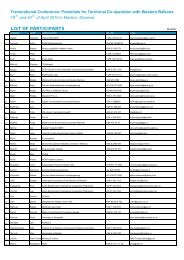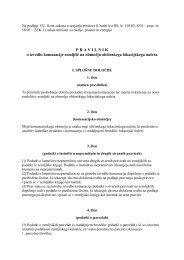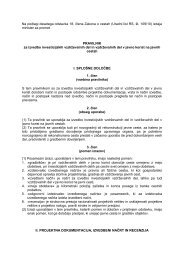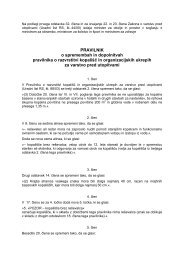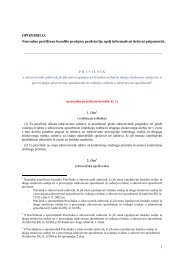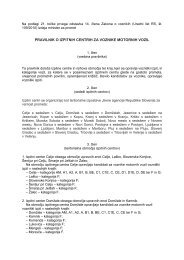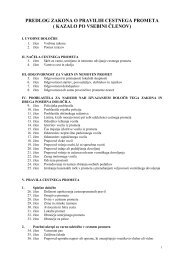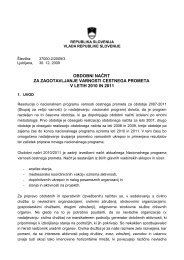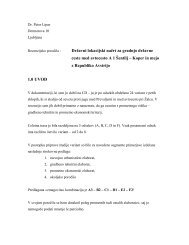- Page 6:
UvodIntroductionCilj Evropske konve
- Page 9 and 10:
VsebinaContentUVOD / INTRODUCTION 5
- Page 11:
mag. Marko Prem 260Upravljanje kraj
- Page 14 and 15:
dejavnikov je torej vplivalo na to,
- Page 16 and 17:
METKA ČERNELČGeneralna direktoric
- Page 18:
avneh vključuje in usmerja razvoj
- Page 21 and 22:
Pozdravni nagovori/ Welcoming Speac
- Page 23 and 24:
Pozdravni nagovori/ Welcoming Speac
- Page 25 and 26:
Pozdravni nagovori/ Welcoming Speac
- Page 27 and 28:
Pozdravni nagovori/ Welcoming Speac
- Page 29 and 30:
Pozdravni nagovori/ Welcoming Speac
- Page 32 and 33:
DELAVNICA WORKSHOP 1Inventarizacija
- Page 34 and 35:
vsega tega je bil razpršen sistem
- Page 36 and 37:
žalost pa je bilo izdelanih le mal
- Page 38 and 39:
področje varstva in razvoja kultur
- Page 40 and 41:
- Odstranjujejo potrebo po optimira
- Page 42 and 43:
dejstvo pa je, da omogoča sodelova
- Page 44 and 45:
Krajina kot nacionalni simbolLandsc
- Page 46 and 47:
2. Diagram cikličnih interakcij me
- Page 48 and 49:
prostorom skladne predstave, h kate
- Page 50 and 51:
pojmovana kot država ali kot regij
- Page 52 and 53:
Pri razvijanju Evropske konvencije
- Page 54 and 55:
Regionalna razdelitev krajinskih ti
- Page 56 and 57:
1. 1. Postopek krajinske regionaliz
- Page 58 and 59:
jih intenzivnejšega prostorskega r
- Page 60 and 61:
Krajina je bila vrednotena na lestv
- Page 62 and 63:
Pojem prepoznavnosti krajine je v S
- Page 64 and 65:
e) in the development of agricultur
- Page 66 and 67:
krajine kot demokratičnega koncept
- Page 68 and 69:
ni mogoče »varovati«; takšen pr
- Page 70 and 71:
16. HLC on the web - Devon (made by
- Page 72 and 73:
kot je bilo omenjeno že zgoraj, po
- Page 74 and 75:
Razvijanje rešitev, ki zagotavljaj
- Page 76 and 77:
je mogoče ohraniti v rezervatu, ve
- Page 78 and 79:
kar je v velikem nasprotju z region
- Page 80 and 81:
vodi k zanimivim možnostim za disc
- Page 82 and 83:
namerava na novo ukrojiti kulturne
- Page 84 and 85:
Pogoj, ki ga ne moremo izključiti
- Page 86 and 87:
dejavnosti, da bi zagotovili večjo
- Page 88 and 89:
scape in consolidating their own id
- Page 90 and 91:
Delamo pod vplivom paradoksa: kraji
- Page 92 and 93:
skupine modelov za spreminjanje oko
- Page 94 and 95:
zamišljeni z namenom sobivanja, pa
- Page 96 and 97:
meri 13 kilometrov in priča o viso
- Page 98 and 99:
po našem mnenju moralo služiti ko
- Page 100 and 101:
Glede druge točke pa: umetniki so
- Page 102 and 103:
Vloge, ki jih odigrajo igralci in t
- Page 104 and 105:
Podoba prostora izhaja iz fizičneg
- Page 106 and 107:
Diskusija ob koncu delavnice je bil
- Page 108:
107Delavnica 1 / Workshop 1
- Page 111 and 112:
Pomen kakovostne krajine za boljšo
- Page 113 and 114:
112Delavnica 2 / Workshop 2krajinsk
- Page 115 and 116:
114Delavnica 2 / Workshop 2Evropski
- Page 117 and 118:
116Delavnica 2 / Workshop 2politiko
- Page 119 and 120:
UNESCOVA izbira kulturne krajine:pr
- Page 121 and 122:
120Delavnica 2 / Workshop 2proti re
- Page 123 and 124:
122Delavnica 2 / Workshop 2štiri s
- Page 125 and 126:
124Delavnica 2 / Workshop 2Nedavni
- Page 127 and 128:
126Delavnica 2 / Workshop 2Poudarja
- Page 129 and 130:
Vključenost krajine v javne politi
- Page 131 and 132:
130Delavnica 2 / Workshop 2Dostopno
- Page 133 and 134:
132Delavnica 2 / Workshop 2»od zgo
- Page 135 and 136:
134Delavnica 2 / Workshop 2kmetijst
- Page 137 and 138:
136Delavnica 2 / Workshop 2Transpor
- Page 139 and 140:
138Delavnica 2 / Workshop 2Krajinsk
- Page 141 and 142:
140Delavnica 2 / Workshop 2kmetijst
- Page 143 and 144:
Krajina kot vir za razvoj turizma (
- Page 145 and 146:
144Delavnica 2 / Workshop 2zanimajo
- Page 147 and 148:
146Delavnica 2 / Workshop 224. E. K
- Page 149 and 150:
148Delavnica 2 / Workshop 2Za podro
- Page 151 and 152:
Vloga celovite presoje vplivov na o
- Page 153 and 154:
152Delavnica 2 / Workshop 2trajnost
- Page 155 and 156:
154Delavnica 2 / Workshop 2verjeten
- Page 157 and 158: 156Delavnica 2 / Workshop 2Krajina
- Page 159 and 160: 158Delavnica 2 / Workshop 2Izkušnj
- Page 161 and 162: 160Delavnica 2 / Workshop 2V primer
- Page 163 and 164: 162Delavnica 2 / Workshop 2podežel
- Page 165 and 166: open to opinions from a wider exper
- Page 167 and 168: 166Delavnica 2 / Workshop 2zasedanj
- Page 169 and 170: 168Delavnica 2 / Workshop 2INTERREG
- Page 171 and 172: 170Delavnica 2 / Workshop 2naravnih
- Page 173 and 174: 172Vse države (države članice, d
- Page 175 and 176: 174Delavnica 2 / Workshop 2stežka
- Page 177 and 178: 176Delavnica 2 / Workshop 2Delta Do
- Page 179 and 180: 178Delavnica 2 / Workshop 2podkonzu
- Page 181 and 182: 180Delavnica 2 / Workshop 2zapušč
- Page 183 and 184: 182Delavnica 2 / Workshop 2Suline:-
- Page 185 and 186: 184Delavnica 2 / Workshop 2Z razvoj
- Page 187 and 188: 186Delavnica 2 / Workshop 2sent, ki
- Page 189 and 190: 188Delavnica 2 / Workshop 2težko,
- Page 191 and 192: Od nočne krajine, ki jo razsvetlju
- Page 193 and 194: 192Delavnica 2 / Workshop 2Seznanja
- Page 195 and 196: 194Delavnica 2 / Workshop 2ukrepa p
- Page 197 and 198: 196Delavnica 2 / Workshop 2Nočno t
- Page 199 and 200: . . . . . . . . . . .. . . . . . .
- Page 201 and 202: Varstvo in upravljanje krajine v Sl
- Page 203 and 204: 202Delavnica 3 / Workshop 3varovani
- Page 205 and 206: 204Delavnica 3 / Workshop 3Sprememb
- Page 207: 206Delavnica 3 / Workshop 3način p
- Page 211 and 212: 210Delavnica 3 / Workshop 3dela, ce
- Page 213 and 214: 212Delavnica 3 / Workshop 3številn
- Page 215 and 216: 214Delavnica 3 / Workshop 3Krajinsk
- Page 217 and 218: Varstvo in upravljanje krajine:izku
- Page 219 and 220: 218Delavnica 3 / Workshop 3številn
- Page 221 and 222: Kulturna krajina kot kulturna dedi
- Page 223 and 224: 222Delavnica 3 / Workshop 3naravnih
- Page 225 and 226: 224Delavnica 3 / Workshop 3(Gorjanc
- Page 227 and 228: 226Delavnica 3 / Workshop 31. njivs
- Page 229 and 230: 228Delavnica 3 / Workshop 3V. Smern
- Page 231 and 232: 230Delavnica 3 / Workshop 3- prikaz
- Page 233 and 234: 232Delavnica 3 / Workshop 3prepozna
- Page 235 and 236: Krajina in suburbanizirana območja
- Page 237 and 238: 236Delavnica 3 / Workshop 3dejanske
- Page 239 and 240: 238Delavnica 3 / Workshop 3Morfolo
- Page 241 and 242: 240Delavnica 3 / Workshop 3vendar v
- Page 243 and 244: 242Delavnica 3 / Workshop 3turisti
- Page 245 and 246: 244Delavnica 3 / Workshop 3preobrem
- Page 247 and 248: 246Delavnica 3 / Workshop 3okolja r
- Page 249 and 250: 248Delavnica 3 / Workshop 3Politika
- Page 251 and 252: 250Delavnica 3 / Workshop 3uveljavi
- Page 253 and 254: 252Delavnica 3 / Workshop 3Obiskova
- Page 255 and 256: 2549. Ali so župani parkov razdvoj
- Page 257 and 258: 256Delavnica 3 / Workshop 3v izjemn
- Page 259 and 260:
258Delavnica 3 / Workshop 3Ta mrež
- Page 261 and 262:
Urejanje krajine v obalnih območji
- Page 263 and 264:
262Delavnica 3 / Workshop 3zelenih
- Page 265 and 266:
264Delavnica 3 / Workshop 3obalnih
- Page 267 and 268:
266Delavnica 3 / Workshop 3značiln
- Page 269 and 270:
268Delavnica 3 / Workshop 3Korčula
- Page 271 and 272:
270Delavnica 3 / Workshop 3njem raz
- Page 273 and 274:
272Delavnica 3 / Workshop 3da so se
- Page 275 and 276:
274Delavnica 3 / Workshop 3načrtov
- Page 277 and 278:
276Delavnica 3 / Workshop 3Vpliv pr
- Page 279 and 280:
278Delavnica 3 / Workshop 38. Zaklj
- Page 281 and 282:
. . . . .. . . . . . . .. . . . . .
- Page 283 and 284:
Veščine usposabljanja javnosti za
- Page 285 and 286:
284Delavnica 4 / Workshop 4pod kak
- Page 287 and 288:
286Delavnica 4 / Workshop 4Metoda 1
- Page 289 and 290:
288Delavnica 4 / Workshop 4širokeg
- Page 291 and 292:
290Delavnica 4 / Workshop 4- Združ
- Page 293 and 294:
292Delavnica 4 / Workshop 4mladino
- Page 295 and 296:
294Delavnica 4 / Workshop 4Povezave
- Page 297 and 298:
Strategija izobraževanja o prostor
- Page 299 and 300:
298Delavnica 4 / Workshop 4Za trajn
- Page 301 and 302:
300Delavnica 4 / Workshop 4in nikol
- Page 303 and 304:
302Delavnica 4 / Workshop 4- upošt
- Page 305 and 306:
304Delavnica 4 / Workshop 4večstra
- Page 307 and 308:
306Delavnica 4 / Workshop 4Poglavit
- Page 309 and 310:
308Delavnica 4 / Workshop 4- začet
- Page 311 and 312:
310Delavnica 4 / Workshop 4krajini,
- Page 313 and 314:
312Delavnica 3 / Workshop 3Vsi nagr
- Page 315 and 316:
Splošni zaključki / General concl
- Page 317 and 318:
Splošni zaključki / General concl
- Page 319 and 320:
Splošni zaključki / General concl
- Page 321 and 322:
Splošni zaključki / General concl
- Page 323 and 324:
Splošni zaključki / General concl
- Page 325 and 326:
Splošni zaključki / General concl
- Page 327 and 328:
Splošni zaključki / General concl
- Page 329 and 330:
Seznam avtorjevList of SpeakersFran
- Page 331 and 332:
Nicolas SANAAZdruženje regionalnih
- Page 333:
FRIDAY 12 MAY 2006PROGRAMMEWORKSHOP



